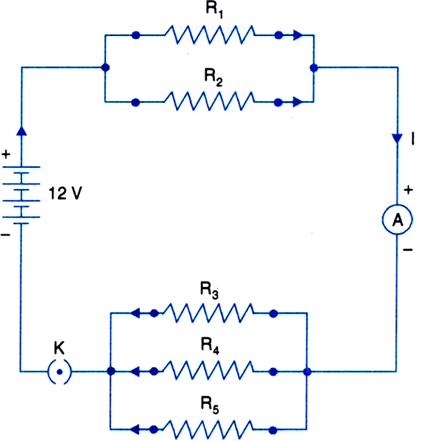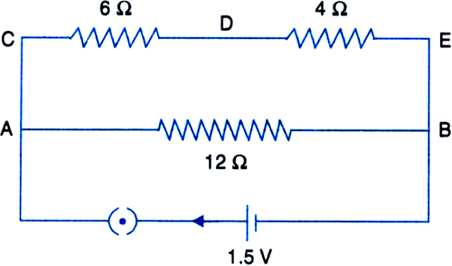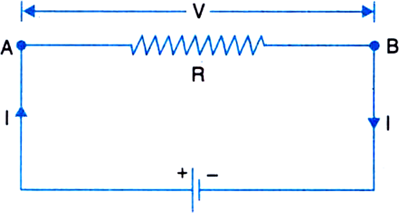If, in Fig. and a 12 volt battery is connected to the arrangement, calculate (a) the total resistance and (b) the total current flowing in the circuit.
(a) Let R' be the equivalent resistance of R1 and R2.
Here, R1 = 10 , R2 = 40 and they are connected in parallel with each other.
So,
Let, R'' be the equivalent resistance of which are connected in parallel.
So, their combinational resistance is,
i.e.,
Therefore, Total resistance is given by
(b) Total current flowing in the circuit is,
A 40 watt lamp requires 0.182 A of current of 220 volts, while a 60 watt lamp requires 0.272 A of current at 220 volts. If a 40 watt lamp and a 60 watt lamp are connected in series with a 220 volt line, how many amperes of current will flow through each lamp?
Lamp A:
Power of lamp, P1 = 40 W
Amount of current required by the lamp, I1 = 0.182 A
Voltage of the supply, V = 220 V
Lamp B:
Power of bulb : P2 = 60 W
Current required by the lamp: I2 = 0.272 A
Voltage, V = 220 V
Resistance of lamp A,
Resistance of lamp B,
Equivalent resistance when the two lamps are connected in series, R = R1 + R2
= 1208.8 + 808.8
= 2017.6 Ω
Current through each lamp when, connected to a 220 V line is given by,
In the circuit diagram shown in Fig,
calculate
(i) the current through the arms AB, AC and CDE and
(ii) the potential difference across AB, CD and DE. 
(i) As shown in the fig. resistances RCD and RDE are in series, so their equivalent resistance is
RCE = RCD + RDE = 6 + 4 = 10 Ω
Resistances RCE and RAB are in parallel, their equivalent resistance R is given by,
Total current in the circuit is,
As resistances across AB and CE are in parallel, so potential difference across each of them is same i.e., 1.5 V.
That is,
Therefore, current flowing across IAC and ICE is given by,
Hence, current across AB is given by,
(ii) Potential difference across AB, CD and DE respectively given by,
Heating effect of current:
Let us cosider a circuit which consists of only resistors, connected to a battery. That is, a purely resistive circuit is under consideration. The energy expended by the battery gets dissipated in resistors in the form of heat.
The phenomenon of production of heat in a resistor by the flow of an electric current through it is called heating effect of current or Joule heating.
Cause of heating effect of current:
When a potential difference is applied across the ends of a conductor, electrons get accelerated from negative terminal to positive terminal. During the course of their motion, these electrons collide frequently against one another and against the atoms of the conductor. At each collision, a part of kinetic energy of the electron gets converted into heat and this increases the temperature of the conductor.
Derive an expression for the heat produced in a resistor R when a voltage drop across it is V.
Or
Prove that the heat produced in a conductor of resistance R on passing current I through it for time t is
Hence state Joule’s law of heating.
Heat produced by electric current—Joule’s law of heating: As shown in Fig, consider a resistor AB of resistance R connected across a cell of voltage V. Suppose a current I is flowing through it.
The amount of charge that flows from A to B in time t is given by
Q = I x t [∵ I = Q / t]
Fig. Heat produced in a resistor.
By definition of potential difference, the work done in carrying unit charge from A to B = V.
∴ Work done in flowing charge Q from A to B is W = V x Q = V x It
This energy is spent in overcoming the resistance offered by the resistor. If whole of the energy appears as heat, then the amount of heat produced is
![]()
![]()
or ![]()
The above equations represent Joule's law of heating. This law states that the amount of heat produced in a conductor is:
(i) directly proportional to the square of the current,
(ii) directly proportional to the resistance of the conductor, and
(iii) directly proportional to the time for which the current is passed.
